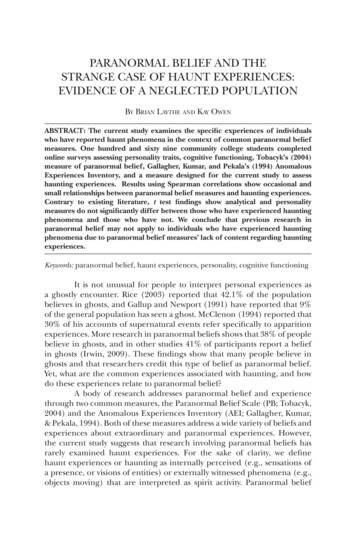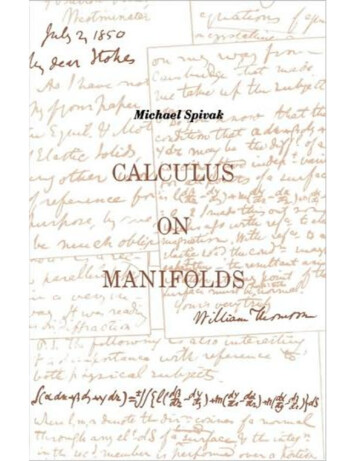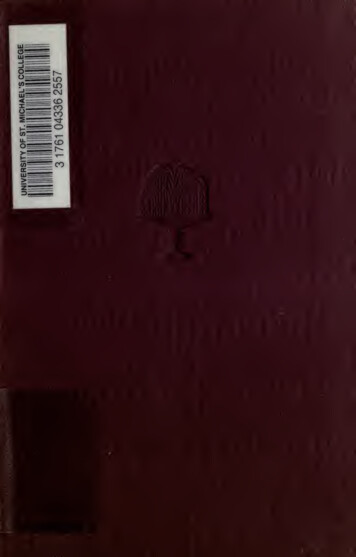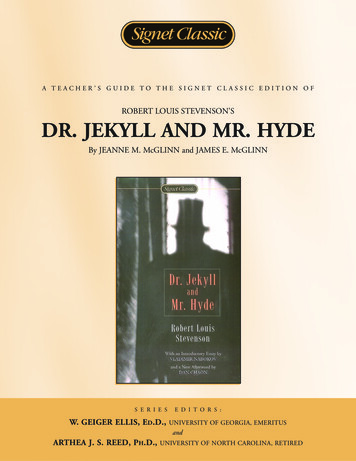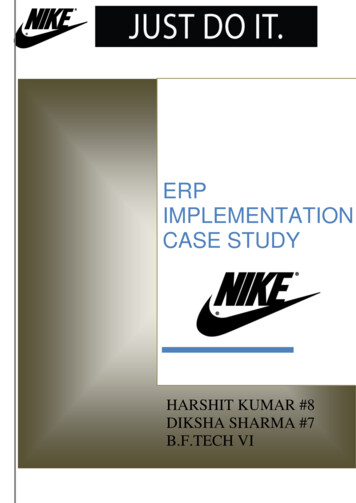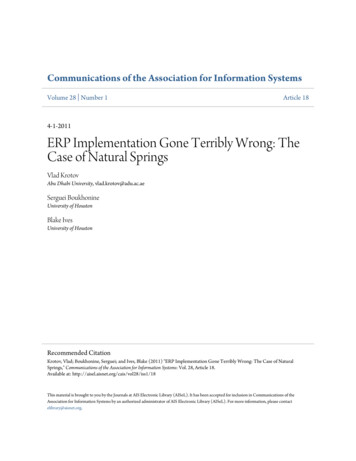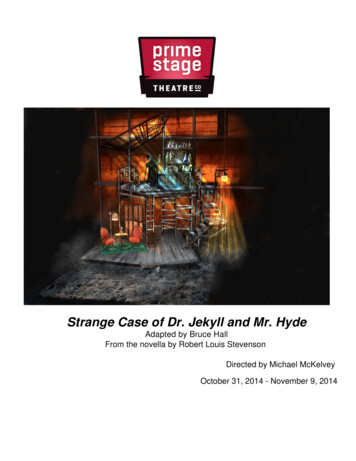
Transcription
Strange Case of Dr. Jekyll and Mr. HydeAdapted by Bruce HallFrom the novella by Robert Louis StevensonDirected by Michael McKelveyOctober 31, 2014 - November 9, 2014
Our Eduction Programmingis funded in part by the following:Literacy in ActionStudent Matinee Field TripsTheatre Mentor/InternsProfessional DevelopmentEducation DirectorBringing Literature to LifeTeen Dating Awarness
POST--‐SHOW CHAT SESSIONSStay after the school matinees to ask questions of both the actors and the productioncrew! During the 15-minute post-show chat sessions, delve into the story and then askquestions of the actors about the rehearsal process, theatre performance, and theirexperiences working on that particular production. No registration requiredTHE LITERACY IN ACTION PROGRAMPrime Stage Theatre’s flagship education program strives to increase adolescent literacythrough theatre in underserved and underperforming school districts in the WesternPennsylvania area. In this FREE program, schools receive tickets and books for each PrimeStage production, 10 in-school workshops, and professional development opportunities forteachers. If you would like your school to become involved, please download an applicationat our website, http://primestage.com/files/pdf/application aas.pdf.TEEN DATING AWARENESS PROGRAMPrime Stage Theatre is proud to offer a touring production of You Belong to Me a 60 minuteprogram designed to identify the warning signs of teen dating violence that can help save the lifeof a friend, loved one or even you. The three part program includes the testimony of a parentwho lost a child, the one-act performed by Pittsburgh area teens, and a Q&A session. Thisprogram will make an impact at your school or community center. If you would our Teen DatingAwareness Program to come to your school or community center, please visit our website,http://www.primestage.com/education/teen dating awareness.htmlOTHER OPPORTUNITIES FOR TEENS, FAMILIES AND ADULTSPrime Stage Theatre offers opportunities for people of all ages to get involved with the theater.Check out our website to learn about the Mentorships, Volunteering, Book Readings and manyother exciting events. There is something for everyone at Prime Stage! http://primestage.com/3
Strange Case of Dr. Jekyll and Mr. Hyde- Resource GuideWelcome to Prime Stage Theatre:10.31.2014Bringing Literature to Life!Check out what’s inside!Dear Educator,Welcome to Prime Stage Theatre’s 2014-2015Turn of the Screw, 2013-2014The Importance of Being Earnest,2013-2014The Devil’s Arithmetic, 2013-2014Dr. Jekyll and Mr. Hyde in3 minutes . or less5season!Robert Louis Stevenson,Author6This year, we are pleased to bring you thethillStrangeCase of Dr. Jekyll and Mr. Hyde,Where did Stevenson getthe idea?7George Orwell’s classic story – Animal Farm,and the world’s longest running mystery,The Mousetrap by Agatha Christie.Deacon Brodie8Adaptations9Cast of Characters10Student Activity11Watching a play12Tings to Look For13This Resource Guide is designed to providehistorical background and context, classroomactivities and curricular content to help youenliven your students’ experience with theliterature. We hope it will inspire you to usetheatrical games and creative thinking in yourclassroom in order to spark personal connectionswith the theme and characters in the stories.If you have any questions about the informationor activities in this guide, please contact me. I’mhappy to help and welcome your suggestions!Linda HastonEducation Directorlhaston@primestage.comCool Writing & Discussion14ActivitiesPoint of View15Meaningful Moments16Etiquette House rules17Lesson Plans18-22PA Core Standards!23All Prime Stage productions and Resource Guides address the following PA Core standards:CC.1.3.9-10.A: Determine a theme or central idea of a text and analyze in detail its development over the course of the text,including how it emerges and is shaped and refined by specific details; provide an objective summary of the text.CC.1.3.9-10.C: Analyze how complex characters develop over the course of a text, interact with other characters, and advance theplot or develop the theme.CC.1.3.9-10.D: Determine the point of view of the text and analyze the impact the point of view has on the meaning of the text.CC.1.3.9-10.E: Analyze how an author’s choices concerning structure, order events within it and manipulate time create an effect.CC.1.3.9-10.F: Analyze how words and phrases shape meaning and tone in texts.CC.1.3.9-10.G: Analyze the representation of a subject or a key scene in two different artistic mediums, including what isemphasized or absent in each treatment.CC.1.3.9-10.H: Analyze how an author draws on and transforms themes, topics, character types, and/or other text elements.CC.1.3.9-10.K: Read and comprehend literary fiction on grade level, reading independently and proficiently.CC.1.5.9-10.A: Initiate and participate effectively in a range of collaborative discussions on grades level topics, texts, and issues,building on others’ ideas and expressing their own clearly and persuasively.CC.1.5.9-10.G: Demonstrate command of Standard English when speaking based on grade level and content.4
Strange Case of Dr. Jekyll and Mr. HydeThe novella in 3 minutes or less."If each, I told myself, could be housed in separate identities,life would be relieved of all that was unbearable."— Henry JekyllNote that the original title was Strange Case of Dr. Jekyll andMr. Hyde, omitting the "The" for some reason.The book begins with a mystery. When a girl is brutally attacked late one night,her attacker, calling himself Mr. Edward Hyde, buys off the witnesses with acheck for a small fortune, signed by the eminently respectable Doctor HenryJekyll.Jekyll's friend and legal advisor, Gabriel John Utterson, is disturbed when helearns this, since Jekyll has recently made Hyde his heir. While Uttersoninvestigates this, Hyde is witnessed committing a savage murder of a prominentMember of Parliament. Jekyll claims there is nothing to worry about, but Uttersonbecomes convinced his friend is being blackmailed.Before Utterson can do anything, Jekyll's butler Poole (Pauline in the script)contacts Utterson to report that a stranger has locked himself in the lab. Whenthey break into the room they find Hyde, having committed suicide by poison, andtwo letters explaining everything.Jekyll had been trying to invent a potion which could separate his good and evil sides.When Jekyll tested it, he was now transformed into 'Mr. Hyde', a manifestation of hisevil side with no trace of morality, but his normal personality remained unchanged. Inother words, as Dr. Jekyll - he was a man with mostly good and some evil urges, asMr. Hyde - he was a man with only evil urges. After some cautious experimenting,Jekyll decided he liked this side-effect. As Mr. Hyde, he could indulge himself in everypleasurable vice, and never be suspected as Hyde looked completely different.However, Hyde eventually committed murder, Jekyll resolved never to use the potionagain.But after a few months, Jekyll began spontaneously changing into Hyde.Only by drinking the potion could he retain his own form, and the potionwas running out — not to mention that ever since the murder, the policehad been searching relentlessly for Edward Hyde. When Jekyll made a newbatch of the potion, it didn't work; his original chemical samples had beencontaminated, and it was the impurities that had made the transformationpossible. At the end of his letter, Jekyll writes that he soon will change intoHyde, and thus his life will end.Photos from PST production ofStrange Case of Dr. Jekyll and Mr. Hyde5
Robert Louis Stevenson, Author"Men are born with various manias: from my earliest childhood, it was mine tomake a plaything of imaginary series of events; and as soon as I was able towrite, I became a good friend to the paper maker."Stevenson was a 19th century Scottish writer notable for such novels asTreasure Island, Kidnapped, and Strange Case of Dr. Jekyll and Mr. Hyde.Which ones have you read?Born on November 13, 1850, in Edinburgh, Scotland, Robert Louis Stevenson traveled often, and his globalwanderings lent themselves well to his brand of fiction. His father Thomas belonged to a family of engineerswho had built many of the deep-sea lighthouses around the rocky coast of Scotland. His mother, MargaretIsabella Balfour, came from a family of lawyers and church ministers. In 1857 the family moved to 17 HeriotRow, a solid respectable house in Edinburgh’s New Town.At the age 17, he enrolled at Edinburgh University to study engineering, with the goal of following his father inthe family business. Lighthouse design never appealed to Stevenson, though, and he began studying lawinstead. His spirit of adventure truly began to appear at this stage, and during his summer vacations hetraveled to France to be around young artists, both writers and painters. He emerged from law school in 1875,but did not practice, as, by this point, he felt that his calling was to be a writer.His first published work was an essay called "Roads", and his first published volume at the age of 28, AnInland Voyage, is an account of the journey he made by canoe from Antwerp to northern France. Acompanion work, Travels with a Donkey in the Cevennes (1879), gives more of his thoughts on life andhuman society and continues to build the image of the narrator.Stevenson has an important place in the history of the short story in the British Isles: the form had beenelaborated and developed in America, France and Russia from the mid-19th century, but it was Stevenson whoinitiated the British tradition. His first published fictional narrative was "A Lodging for the Night" (1877), a shortstory originally published in a magazineTreasure Island and "Children's Literature"While on holiday in Scotland in the summer of 1881, cold rainy weather forced the family to amusethemselves indoors. One day Stevenson and his twelve-year-old stepson drew, colored and annotated themap of an imaginary "Treasure Island". The map stimulated Stevenson’s imagination and, "On a chillSeptember morning, by the cheek of a brisk fire" he began to write a story based on it as an entertainmentfor the rest of the family. It was his first volume-length fictional narrative, and the first of his writings forchildren. Later works are A Child’s Garden of Verses (1885), The Black Arrow (1883), and Kidnapped (1886).Stevenson was extraordinarily well-travelled, a lover of sailing on the seas, and of finding new adventures theworld over. He died in December 1894 and was buried at the top of Mount Vaea above his home on Samoa.Appropriately it was a part of his own short poem, "Requiem" (from an 1887 collection), that was written onhis tomb: "Under the wide and starry sky, / Dig the grave and let me lie."6
Strange Case of Dr. Jekyll and Mr. HydeWhere did Stevenson get the idea?The tale originally came to its author in a dream.Robert Louis Stevenson had always trusted to "brownies" –meaning his daydreams and nightmares. He felt that storiesand characters were being channelled to him fromelsewhere.As a young man his fantasy life had been kept in check. Hehad grown up in a family of engineers and was himselfdestined for a career in the law. He lived with his family in alarge house in Edinburgh's "New Town" (constructed to arational, geometric design in the late 18th century).But New Town became the squalid, overcrowded anddownright dangerous "Old Town" (the stretch of Edinburghbetween Castle Rock and the Palace of Holyrood). Stevensonwas captivated by the Old Town, and would tiptoe out of thehouse when everyone else was asleep, climbing the steepslope towards drink and debauchery.He knew fine well that there were two sides to Edinburgh –he'd known it since childhood. In his bedroom there stood awardrobe constructed by William Brodie, and youngStevenson's nanny would tell him the story of Brodie, whohad been a respected citizen by day but housebreaker bynight. Here was the duality of Man – not only in the figure ofBrodie but also apparently built into the construction of thecity itself – light and dark, the rational and the savage.Stevenson suffered ill-health all his life, and was being dosedwith an experimental drug by Doctor John Hunter at the timewhen his "brownies" assailed him with the story of the gooddoctor and his evil other self.Hunter was known in all the right circles. He was marriedto a patron of the arts who would give grand parties attheir home. But if you continued through the house youcame to Hunter's surgery. You might also be shown hisvast collection of weird and wonderful specimens. Andeventually, you'd find yourself in the crampedaccommodation used by his students, beyond which a doorled out into a narrow alley off what is now Charing CrossRoad. This was where, at dead of night, the grave-robbersarrived with fresh deliveries of cadavers.Prime Stage – Strange Case of Jekyll and HydeWhen Jack the Ripper began his work, thepublic began to suspect that Hyde himselfmight be real. And remember . Jack, too,was reputed to be a medical man.John Hunter did like his little experiments. When you readDr Jekyll and Mr Hyde, look for the similarities.7
Deacon Brodie – An Inspiration for Stevenson’s Dr. Jekyll and Mr. HydeThe young ladies in the drawing-room could not stop talking about thehandsome and prosperous bachelor who was coming to tea.“What a wonderful husband he would make,” they said to each other. “He’sbound to marry soon. I wonder which one of us it will be?”“Quiet!” said the girl keeping lookout at the window. “He’s knocking at the frontdoor now. He’s dressed all in white – just like a saint.”And saintly was how William Brodie appeared to wealthy merchants inEdinburgh society. A bachelor of temperate habits, a city councilor, a skillfulcabinet-maker and carpenter, he seemed faultless. The only thing held againsthim was his shyness and modesty that made him a difficult person to reallyknow.They little guessed then that William Brodie was hiding plenty from them. Abashful bachelor, he maintained two “wives” in separate houses. He had children by both women, and the onlyrelative to visit him before he was hanged was his favorite daughter Cecil.Garbed in spotless white by day, after dark Brodie changed into a suit of black for his visits to low taverns,gambling dens, and the rowdy cock-fighting pits that were his favorite place of relaxation. And when engaged onactual break-ins and burglaries, he wore a mask of black crepe.During his career as a burglar, Brodie preferred to work alone. His made putty impressions of the shop keys hehad access to during his working hours, then used the keys to enter the homes at night. He robbed bank-houses,jewelers, goldsmiths, diamond merchants and even the private residences of some of his closest society friends.But Brodie was not satisfied to keep his talents to himself. He wanted a gang to aid him and applaud his criminalgenius. His hero was Captain Macheath, the highwayman in John Gay’s lyrical drama, The Beggar’s Opera. And,like “Mac the Knife,” he saw himself as a villain with dash, swagger and a gentlemanly disregard for the law and acavalier regard for the ladies.Brodie organized a raid on the General Excise Office for Scotland. His target was the hundreds of pounds of taxmoney kept there. Already a price of one hundred pounds had been placed on his head by the Edinburgh police,and his foolish pride wanted to see the reward raised.The planning and initial progress of the theft went smoothly. Then a returning official noticed something wasamiss in the building and gave the alarm. Brodie and his men escaped, but the following day one of them thoughtthat Brodie’s mismanagement had lost them their loot. He went to the police and turned King’s Evidence. Brodiewas arrested in disgrace in the city that had offered him so much.At fourteen, Stevenson wrote a crude play about Brodie. He revised it when he was twenty-five and had it staged,with little success, in London and New York. At thirty-six, Stevenson used Brodie as the model for Strange Case ofDr. Jekyll and Mr. Hyde.There is a tavern named after William Brodiein Royal Mile Edinburgh within a short stroll ofEdinburgh Castle, Waverley Station andGeorge IV Bridge.A statute of Brodie stands in front.8
Jekyll and Hyde Some AdaptationsStage 1887, stage play opened in Boston. The first serious theatrical rendering, it went on to tour Britain and ranfor 20 years. Sullivan reworked the plot to center around a domestic love interest. 1991, stage play opened in London. Written by David Edgar for the Royal Shakespeare Company. The play isnotable for its fidelity to the book's plot. 1997, musical U.S. Jekyll & Hyde. Music by Frank Wildhorn, book and lyrics by Leslie Bricusse. Originallyconceived for the stage. This musical features the song "This Is The Moment". 2009, a new theatrical adaptation by playwright Jeffrey Hatcher. 2012, A re-vamped North American touring production, featured a contemporary rock score, ConstantineMaroulis played the lead roles and was directed by Newsies director, Jeffrey Calhoun. 2013, a version of the story presented at the Edinburgh Fringe Festival, explores Jekyll as a woman.Film 1912, USA, First USA production based on Richard Mansfield's stage performance. 1920, USA, A famous silent film version, starring John Barrymore. Plot follows the Sullivan version of 1887,with elements from The Picture of Dorian Gray. 1920, Germany, Der Januskopf (literally, The Janus-Head, Janus being a Roman God depicted with twofaces). Directed by F. W. Murnau. 1931, USA, Known for its acting, visual symbolism, and special effects, it follows the Sullivan plot. FredricMarch won the Academy Award for his portrayal. The technical secret of the transformation scenes was notrevealed until after the director's death. 1941, U.S., A remake of the 1931 movie, it stars Spencer Tracy, Ingrid Bergman, and Lana Turner. "This iswhen JEEK-ull became JEK-ull". 1972, Spain, Dr. Jekyll y el Hombre Lobo, pits Dr. Jekyll against a werewolf. 1981, UK, with David Hemmings in the dual role. Jekyll's body turns into Mr. Hyde upon his death. 1989, U.S., Edge of Sanity, a low-budget adaptation with Anthony Perkins as a Jekyll, whose experimentswith synthetic cocaine transform him into Hyde, who is also Jack The Ripper. 2015, U.S. Starring Gianni Capaldi, Shaun Paul Piccinino, and Mickey Rooney in his last film appearance.Music The Who release the song "Dr. Jekyll and Mr. Hyde" on the Magic Bus album. Men At Work released the song "Dr. Heckyll and Mr. Jive" on their album CargoQuestions --‐ Jekyll and Hyde has been adapted many times.Why do you think this is the case?In the play by Bruce Hall, some roles have changed from the novella. How could this affect the audience’sunderstanding of the events in the play? Would it heighten or lessen the dramatic tension?9
Volume 5, Issue 1Bruce Hall’s ScriptBruce Hall’s stage adaptation of Strange Case of Dr. Jekyll and Mr. Hyde.When you see the play, think about how you might choose a cast to portray these characters.*What physical characteristic would you look for in the actor playing each character?Why? *What vocal quality would you expect each character to have? Would they speakslowly, quickly, gravelly, squeaky?*Which roles might be shared by one actor? How would you make each character unique?CAST OF CHARACTERSDoctor Lanyona former associateof Jekyll'sSeth Utterson Sir Danvers Ca rewDiana CarewDiana's fatherJekyll's fiancéea lawyer, and oldfriend of Jekyll'sDoctor JekyllEdward HydeM r s . O d iomStreet UrchinHyde's housekeeperPaulineJekyll'sHousekeeperTobiasa Young Newsboy10
STUDENT ACTIVITYDISCUSS WITH YOUR STUDENTS!How would you adapt StrangeCase of Dr. Jekyll and Mr. Hyde as a play?*What is the most important message to you? How could you bring that message to the forefront forthe audience?*What questions remain unanswered in the novella? How could you add scenes or dialogue to add to thestory? *Consider the events that happened before or after the events in the novel, or during the passage oftime. *Theater uses sight and sound! How could you use lighting, costumes, props, sound effects ormovementDiscussion, essay or questions to help you create the adaptation:1. What are the differences between Stevenson’s novella and Bruce Hall’s adaptation?3. Where do you think the source of evil lies in the play?2. From whose point of view are the events told?Characters5. Does Jekyll’s social and religious background influence his actions in the play? If so, how?3. If you were Utterson, would you believe and help Dr. Jekyll? Give support to your argument.3. Why do you think Pauline stayed with Dr. Jekyll? Would you?1. Which character do you empathize with the most? Give support to your argument.5. Do you feel Dr. Jekyll was making the right decisions? Give support to your argument.The Theatre Production Staff who create the ShowThe people who create a play are the Playwright, Set Designer, Lighting Designer, Costume Designer,Sound Designer, Technical Director/Carpenter, Stage Manager, Stage Managers, Production Manager,Director and the actors.After you create your adaptation, form a production team to decide how you would create theproduction – what it would look like, who would direct it, and who would be cast in the roles.1111
1What’s it like to watch a play?If you are into sports, it is like the difference betweenwatching a game and reading about it. Or it is thedifference between looking at a painting and hearing adescription of it, or listening to music and reading athe way the author intended it to be, and the actorsscore.When you watch a play, you are exposed to the playare pulling you into the drama (or comedy), ratherthan forcing you to create it in your own mind withyour own imagination.What’s so special about watching a play?Watching is usually a far more emotional experience, and it can surprise you far more easily than can justreading the script. You get not only the art of the playwright, but also the art of those who interpreted it anddirected it, acted it, etc.(from http://answers.yahoo.com/question/index?qid 20081006235215AAERMnT).What will be so special about watchingStrange Case of Dr. Jekyll and Mr. Hyde?Watching this play may be new experience for you – because one actor plays both roles of Dr. Jekyll and Mr.Hyde without using any makeup. There is also a British Dialect used in the play and the set is a “Unit Set”which means many different locations will be performed in the space.–Curriculum ConnectionHow does Strange Casehave seen or been in?of Dr. Jekyll and Mr. Hyde compare to other plays or musicals youWrite a review of this production comparing it to other plays or theatre productions you have seen or been in.Take a moment from the play and perform it in your classroom to see if others can see the ghosts or things your charactersees.Select a favorite story and adapt it into a play or take a moment from the story and create a scene for you or others to actout in the classroom.12
Putting it in ContextThere are many objects, places,and special references used by the author to add deeper meaning to a story. Lookingfor and identifying special things in Strange Case of Dr. Jekyll and Mr. Hyde will bring adeeper meaning to the story and play.SecretsSecrets are very important. What doeskeeping a secret mean to you?What secrets are kept and which onesare revealed?MusicMusic is very important to the story. How is itused in the story and the play to create tensionand excitement?What are your favorite songs and why?Hyde’s Flat (apartment) and Jekyll’s labHyde’s flat and Jekyll’s lab are very important tothe story. Do you have special place where youlike to go?Letters and correspondenceLetter writing is very important to the story.How is it used in the story and the play tocreate tension and excitement?How are letters different from textmessages?Create a story around a symbol or object or piece of music and share it withthe class. If you were Diana Carew, Seth Utterson, Dr. Lanyon or anothercharacter, what would you write to Dr. Jekyll?There are even more symbols and specialthings in Dr. Jekyll and Mr Hyde.How many can your class find?13
Cool Writing & Discussion Activities!Inspire your students reflect on Strange Case of Dr. Jekyll and Mr. Hyde.What is a novella? It is a narrative work of prose fiction longer than a short story but shorterthan a novel. A common length is about 50 to 100 pages. "Novellas" are also the Latin Americanversion of soap operas. The stories usually run for about 6 weeks.So "novella" means two things as you hear it these days. The literary meaning is a short formnovel (this is what Steve Martin wrote). It is the Latin American name for a serialized TV show.Strange Case of Dr. Jekyll and Mr. Hyde is an excellent way to introduce severalliterary techniques, including point of view, foreshadowing and imagery. Discuss how thestory is told.*What other films, books, or plays are left open for the audience to decide the ending?*Do you believe Dr. Jekyll made the right decisions for the right reason or was he reallyevil? Write a paragraph or two to prove your ideas using specifics from the text and the play.Prime Stage’s mission, bridging literature, life and learning, encourages students to make personalconnections to literature through meaningful, interactive exploration of the text and themes.The activities are intended to enliven, clarify and enrich text as they read and watch the novel.Personal JournalsDr. Jekyll keeps a journal. Have your student do the same!Ask students to keep their own personal journals so that they can have records of five days intheir lives. They can bring in their own journals or provide them with composition books to beused as journals. Since these journals are private, don't read them. However, providestudents with sustained silent writing time to work on journals. Encourage them to writeabout the trials and triumphs of the past week and what they are grateful for in the past week.At the end of that time, check to see that students have written in their journals and give studentsand opportunity to share their entry with the class if they’d like.Students should be free to take them home to work on as long as they bring them to class.14
Point of ViewPoint of View – When writing, authors and playwrights must decide from what point of view theywant to express their ideas – There are three different choices -- ‐ First person, second person and avariety of third person views. Pronouns can be a clue to identify the point of view being used.Types of Point of ViewFirst Person Point of ViewIn the first person point of view, the narrator does participate in the action of the story. When reading stories in thefirst person, we need to realize that what the narrator is recounting might not be the objective truth. We shouldquestion the trustworthiness of the accounting.Objective Point of ViewWith the objective point of view, the writer tells what happens without stating more than can beinferred from the story's action and dialogue. The narrator never discloses anything about what thecharacters think or feel, remaining a detached observer.Third Person Point of ViewHere the narrator does not participate in the action of the story as one of the characters, but lets us knowexactly how the characters feel. We learn about the characters through this outside voice.Omniscient and Limited Omniscient Points of ViewA narrator who knows everything about all the characters is all knowing, or omniscient. A narrator whoseknowledge is limited to one character, either major or minor, has a limited omniscient point of view.Classroom ActivityDivide the class into small groups and identify apoint of view in one part of the story.Consider how the story would change if thepoint of view changed?What if the story was told by Mr. Utterson?What if the story was told from Dr. Lanyon’sor Diana’s point of view?Create and present a monologue or scenefrom the story as is someone else wastelling it.Create an original story with a character’spoint of view.As you read and/or watch Dr. Jekyll and Mr. Hyde considerthese things:V How does the point of view affect your responses tothe characters?V How is your response influenced by how much thenarrator knows and how objective he or she is?V First person narrators are not always trustworthy. It is upto you to determine what is true and what is not.V Think about the ways that point of view by the charactersin the ork help/files/point of view.pdfRead an article in a journal and determinethe point of view.15
Prime Stage’s mission, bridging literature, life and learning, encourages studentsto reflect on their learning. The activities below are intended to provide opportunityto synthesize the learning and make personal meaning after they have read the textor attended the performance.Meaningful Moments Bubble MuralStudents may choose 1 or 2 moments from the performance (or the novella) thatmade a lasting impression on them. Using pictures and words, create a ThoughtBubble illustrating each moment. Students should try to capture the emotion asthey experienced it. Try to use the same colors, light quality and textures eachobserved in the performance. Students may hang their Thought Bubbles on thewall to create a mural. The mural should give the viewer an authenticunderstanding of what it felt like to be an audience member.Surprising ChoicesWhat surprised you about this production by PrimeStage Theatre? Consider the costumes, set design,music, lighting, special effects, acting and directing.What do you think motivated the production team oractors to make the choices that surprised you? Werethey trying to solve a unique problem, create a strongresponse from the audience, make a creative statementor address some other need? Write a
When Jekyll tested it, he was now transformed into 'Mr. Hyde', a manifestation of his evil side with no trace of morality, but his normal personality remained unchanged. In other words, as Dr. Jekyll - he was a man with mostly good and some evil urges, as Mr. Hyde - he was a man
